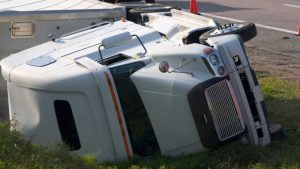While safely maneuvering a large commercial truck can be difficult, this is not an excuse for truck drivers to put other people in harm’s way. This applies when truck...
Read moreTruck Accidents Caused by Blind spots: Who Is At Fault?
 Trucks, buses, and other heavy vehicles tend to have more blind spots than other vehicles because of their large size. Blind spots present significant dangers to any driver, occupant, or motorcyclist who shares a road with large vehicles. Blind spot truck accidents tend to result in severe injuries and fatalities. Recovering compensation after an Oregon truck accident requires an understanding of complex federal and state laws, so truck accident victims should contact the experienced lawyers at D’Amore Law Group. We can discuss your rights and remedies after an accident.
Trucks, buses, and other heavy vehicles tend to have more blind spots than other vehicles because of their large size. Blind spots present significant dangers to any driver, occupant, or motorcyclist who shares a road with large vehicles. Blind spot truck accidents tend to result in severe injuries and fatalities. Recovering compensation after an Oregon truck accident requires an understanding of complex federal and state laws, so truck accident victims should contact the experienced lawyers at D’Amore Law Group. We can discuss your rights and remedies after an accident.
What Are Truck Drivers’ Blind Spots?
Passenger vehicle drivers often assume that truck drivers can see better because they are higher off the ground. However, while truck drivers have a better forward view, they have serious blind spots. These blind spots are often referred to as “No Zones” and include the areas around trucks where a car is no longer visible to the truck driver. Those in a “no zone” are in greater danger of getting into an accident.
According to the National Transportation Safety Board (NTSB), the primary blind spots include:
- Directly in front of the truck (where the driver is too high to see “below” the line of sight for a certain distance);
- Directly behind the truck; and
- Along each side of the truck, especially on the right side.
Generally, drivers who cannot see the truck driver’s reflection in the truck driver’s mirror are likely in the truck’s blindspot.
Blind Spot Truck Accidents
According to the same NTSB study, crashes where large truck drivers needed to use their mirrors to complete maneuvers comprised nearly 20% of all large truck collisions. Further, the report indicated that mirror-related crashes involving the ride side of the truck were more than four times as common than accidents involving the left side of the truck. In light of the growing rate of these serious accidents, researchers are developing new trucking technology to reduce blind spot accidents.
Blind Spot Truck Accident Liability
While many truck drivers try to avoid liability by claiming that the victim was in a blind spot, this fact does not negate the truck driver’s responsibility. Truck drivers should receive extensive training in operating such large vehicles. This training needs to involve learning the importance of identifying their vehicle’s blind spots and taking steps to avoid blind spot accidents.
Truckers could be held liable for blind spot accidents in cases involving the following issues.
Fatigue
Driver fatigue is one of the leading causes of trucking accidents. Truck driver fatigue can result from improper sleep, lengthy work hours, and extensive mental exertion. Fatigue and sleep deprivation often mimic the symptoms of being drunk. This can clearly cause serious impairment to the driver of a big rig, which is a danger to all other road users.
Distracted Driving
A truck driver might be responsible for an accident when they fail to identify vehicles in their blind spot because of distraction. Distraction is any behavior that diverts the truck driver’s attention away from the road. This could include texting, eating, and even talking on their phone or to a passenger.
Impairment
Impairment can stem from many situations; however, it often involves the misuse of prescription or nonprescription drugs or alcohol. Generally, non-commercial drivers 21 years of age and older are considered legally drunk when their blood alcohol content (BAC) is .08% or higher. However, commercial vehicle drivers in Oregon are considered intoxicated when their BAC is .04% or greater.
In these situations, the truck driver could be held liable for any injuries that stem from their negligence. In addition, in some cases, the truck driver’s employer or a third party might also be responsible for the victim’s damages.
Common Blind Spot Accident Injuries
There are many studies on truck accident injuries. Each truck accident presents its unique set of circumstances that can significantly impact the severity of injuries. However, generally speaking, truck accidents often involve more serious, life-changing injuries than accidents between two passenger vehicles.
Traumatic Brain Injuries
Traumatic brain injuries (TBIs) are among the most common injuries in large truck accidents. According to the National Library of Medicine, 1.5 million Americans suffer from a TBI each year. And of that number, over 230,000 people are hospitalized and survive, 50,000 people die, and 80,000 to 90,000 individuals experience long-term disability due to TBIs each year.
Spinal Cord Injuries
Serious collisions with commercial trucks can cause damage to an accident victim’s vertebrae and surrounding ligaments. Victims may experience spinal fractures, spinal dislocations, and spinal stenosis.
Back and Neck Injuries
Many Oregon truck accident victims experience back and neck pain after a collision. These injuries can stem from whiplash, facet joint injuries, spinal fractures, and herniated discs.
Broken Bones
Broken bones can have long-term consequences and often entail costly and painful surgeries. In some cases, accident victims could require rods, pins, and other devices to hold their bones together after a break.
Lacerations and Burns
Collisions between a large truck and a smaller vehicle often involve shattered glass, explosions, and fires. These events can result in deep lacerations, severe burns, and blunt force trauma. In addition to emergency medical services, many truck accident victims require inpatient hospital stays, extensive surgeries, and rehabilitative services.
In some cases, accident victims experience fatal injuries and succumb to their injuries at the accident scene. Others die from their injuries at the hospital or during emergency surgery.
Has a Recent Semi-Truck Accident Turned Your Life Upside Down?
If you or a loved one were recently injured in an Oregon truck accident, the lawyers at D’Amore Law Group want to help. For nearly 30 years, our Oregon and Washington personal injury attorneys have provided aggressive representation to accident victims and their families, helping them recover meaningful compensation for their losses. We offer free consultations, during which we can provide you with an overview of the recovery process, answer your questions, and explain how we can help. To schedule a free consultation with one of our Oregon truck accident lawyers, contact us today.
